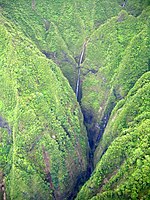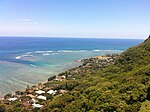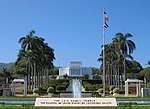Punaluu, Hawaii

Punaluʻu (pronounced [punəluʔu]) is a census-designated place and rural community in the Koʻolauloa District on the island of Oʻahu, City & County of Honolulu, Hawaii, United States. In Hawaiian, punaluʻu means "coral dived for", or in the case of the fishpond once located here, possibly "spring dived for". There is a very small commercial center located beside Punaluʻu Stream, and several condominium projects, including a high-rise building, located at Haleaha Beach and Kaluanui Beach. At the 2020 census, the CDP had a population of 1,374. A fringing reef extends off the shoreline. There are several beaches and a beach park in Punaluʻu, including Punaluʻu Beach Park, Punaluʻu Beach, Haleaha Beach, and Kaluanui Beach. Sugar cane was once grown on the narrow coastal plain inland from the highway. The U.S. postal code for Punaluʻu is 96717.
Excerpt from the Wikipedia article Punaluu, Hawaii (License: CC BY-SA 3.0, Authors, Images).Punaluu, Hawaii
Geographical coordinates (GPS) Address Nearby Places Show on map
Geographical coordinates (GPS)
| Latitude | Longitude |
|---|---|
| N 21.5925 ° | E -157.89694444444 ° |
Address
96717
Hawaii, United States
Open on Google Maps









